You want to avoid hitting a push for a couple of reasons. First, and most obviously, you don't want to push the ball because a push is not going to end up on target. The ball will be at least somewhat right of the fairway or green (again, for a right handed player), and you will have to use your next shot to get back in position. However, missing off-target is not the only problem with a push. Since the club face is almost always going to be left open to the target when the ball is pushed, you will be adding loft to the club and the shot is nearly certain to come up short. So, in the end, you are left with a shot that is both off line and short of the intended target that you had selected. Obviously, if you are going to post good scores on a regular basis, you are going to need to get this miss out of your game as quickly as possible.
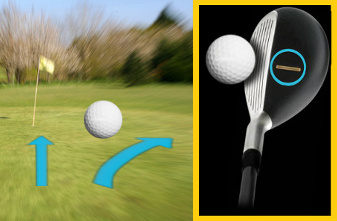
If you have landed on this page, it’s likely because you are struggling with a push shot in your game. Hitting consistent pushes on the course is frustrating, as you will know the ball has no chance to land near the target as soon as it leaves your club. For a right-handed golfer, a pushed shot is one that leaves the club to the right of the target line – and never comes back. These kinds of shots usually fly pretty straight, but they end up far from the target because they were hit on the wrong line from the start.
| GOLF FIXES BY PGA PROS |
|---|
| Correcting The Dreaded Push Slice Golf Ball Flight | Video | Article |
| Fixing The Golf Push | Video | Article |
| Problems with a Push Slice? Here's how to fix it | Video | Article |
| What is a Push Slice and How to Cure this Problem | Video | Article |
| What is a Push Slice Golf Shot | Video | Article |
| LESSONS |
|---|
| Changing A Push Into A Golf Power Fade | Video | Article |
| Practice Hitting A Golf Push Shot To Learn A Power Fade | Video | Article |
| The Technical Details Of The Golf Push Slice | Video | Article |
| PRACTICE DRILLS |
|---|
| Adjusting To A Push Free World Of Golf Shots | Video | Article |
| Drills To Improve Your Golf Push Slice | Video | Article |
| Golf Push Shot, Basket Swing Drill | Video | Article |
| It Is All About Balance With Push Problem | Video | Article |
| GOLF QUESTIONS |
|---|
| What Causes a Golf Push Slice Shot? | Video | Article |
| GOLF EXERCISES |
|---|
| Rolling Push Up For Chest Swing Power | Video | Article |
| Medicine Ball For Push Up Strength | Video | Article |
| Rolling Push Up For Chest Swing Power | Video | Article |
| Staff Push Down For Back and Shoulders | Video | Article |
Getting rid of push shots completely isn’t possible, as you are always going to make bad swing and hit poor shots from time to time – it happens to everyone. What you should be trying to do, however, is reduce the frequency of your push shots. By improving the mechanics of your swing, you should be able to reduce the number of pushes you hit during an average round, and your scores should improve as a result.
In this article, we’ll discuss the topic of pushed golf shots from a variety of angles. We hope to leave you with a thorough understanding of this topic so you can head back out to the range and get to work on improving your technique. At the end, we’ll also discuss how push shots can impact your short game, and what you might be able to do to correct that frustrating error.
All of the content below is written from the perspective of a right-handed golfer. If you happen to play left-handed, please take a moment to reverse the directions as necessary.
— The Two Ingredients for a Push
Almost every golfer would love to improve his or her level of play. Unfortunately, many lack the fundamental knowledge of the game that is required to make meaningful progress. If you don’t understand the basics of how the game works, it will always be difficult to correct your errors and straighten out your shots.
That line of thinking applies to the issue of the push. If you don’t know why you are pushing the ball to the right of your target time and time again, you have almost no chance of making the necessary corrections. So, in this section, we are going to explain what it is that’s happening when you push the ball to the right. This knowledge alone won’t automatically fix your swing, but it’s a big step in the right direction.
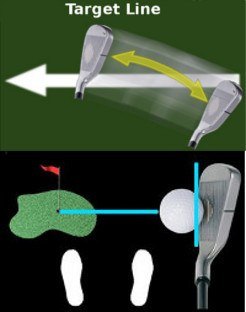
- Swinging on an inside-out path. The first half of this equation is an inside-out swing path. Swinging the club in that direction is going to start the ball to the right of your intended target line, which is required for the shot to be considered a push. There are a variety of swing issues which could lead you to swing from inside-out, and we will get into those later in the article. At this point, it’s enough to simply understand that when you hit a push, you have swung the club at least slightly from inside-out through the hitting area.
- Club face square to the swing path. To hit a true push – where the ball starts to the right of the intended line and flies pretty much straight until it comes down – you will need to have the club face close to square with your swing path when you impact the ball. It’s important to understand that having the face square to your swing path is not the same thing as having it square to the target line. If you are swinging from inside-out, your swing path is pointing to the right of the target, and you’ll only hit a push if the face is roughly square to that path line when you strike the shot. If the face were to be square to the target line at impact, you’d hit a draw (or even a hook) rather than a straight push. It’s the combination of an inside-out swing path and a club face that is square to that swing path at impact which will leave you with a push.
We should take time at this point to mention that an inside-out swing path is not automatically a bad thing. In fact, swinging the club slightly from inside-out, when paired with a club face that is square to the target line at impact, and lead to a beautiful draw. This is the way many of the best golfers in the world play the game. So, if you find as you are working on your game that your club is moving from inside-out through impact, don’t automatically assume that you’ll need to make major changes. As long as that inside-out path isn’t too dramatic, you may simply need to adjust your face position to get back on track.
— Mechanical Mistakes
If you are consistently pushing the ball to the right of your target, it should go without saying that something within your golf swing needs to be fixed. After all, if your swing was working as it should, the ball would be finding its way to the target more often – and the push wouldn’t be as much of an issue. It’s inevitable that you will hit a few pushed shots from time to time but consider making a change if pushed shots become the norm rather than the exception.
Before we talk about what kinds of mechanical mistakes can lead to a push, we need to stop for a moment and make sure what you are doing is actually a push in the first place. Some golfers think they are hitting a push when they are actually just hitting a straight shot with poor alignment. When you send the ball flying on a straight path to the right of your target, it’s important to confirm that this miss wasn’t the result of bad aim. After all, if you aim in the wrong direction when you take your stance, it doesn’t matter how good your swing is – the ball still isn’t going to find the target. Spend some time on the range paying attention to your alignment to make sure that isn’t actually the root cause of your issues.
For those who are missing to the right because they are hitting pushed shots, and not because of faulty aim, the mechanical mistakes listed below might be to blame.
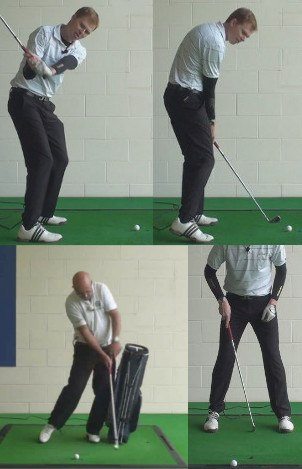
- A loop at the top. One of the easiest ways to wind up with an inside-out swing path is to loop your swing at the top. While it’s possible to have a loop at the top going in either direction, what we are talking about here is one that drops in toward your body as you transition to the downswing. So, your backswing is rather wide and steep, with the club getting out away from your body early on. Then, as you move from the backswing to the downswing, you drop the club inside, and your hands get very close to your right shoulder before you start swinging down. This will usually put the club well to the inside of the target line, and you’ll end up swinging from inside-out in order to strike the ball. If the club face ends up square to that swing path, a push will be the end result. Working yourself away from this kind of a loop in the transition might come back to improving your takeaway move. If you take the club straight back away from the ball, you should be able to avoid this kind of loop without too much trouble. Unfortunately, some golfers let the club get away to the outside of the target line early in the backswing, and that mistake sets them up for trouble later on. Work on improving the way you move the club back from the ball during the takeaway phase and you should be able to at least reduce, if not eliminate, your loop at the top.
- Sliding instead of turning. This is a big one, and it is probably the leading cause of pushed golf shots in the amateur game. During the downswing, you should be turning your lower body aggressively toward the target. When that happens, it’s relatively easy to keep the club near the right plane, and you should be able to swing through on a pretty good path. However, if your lower body rotation lets you down, a wide range of problems can come into play. Where many players get into trouble is during the transition, when they start the downswing by sliding to the left instead of rotating properly. Once you start that sliding action, it’s virtually impossible to stop and you’ll probably do it all the way through impact and into the finish. There are a couple of problems associated with sliding your lower body rather than during it. First, that rotational action can help you build a lot of speed, so you will be missing out on that potential power if your slide. Also, the slide is likely to drop the club well to the inside at the top, and you will end up swinging from inside-out as a result. This is sometimes known as ‘getting stuck’, as the club can feel like it is stuck a little bit behind you as you try to catch up on the way down. Typically, once you are stuck, there are only two likely outcomes for the shot – a push, or a hook. The push will result if you leave the face square with that inside-out path, while you’ll hit a hook if you close down the face before impact arrives. Either way, the shot will be a poor one, and you will be left looking for answers. If you are going to get away from this problem, it will be necessary to improve the way your lower body works in the downswing. By improving your lower body turn, you can make it easier to keep the club in front of you, and that stuck position will be less likely to occur.
- Ball too far back in your stance. This isn’t a mechanical error in the sense of something going wrong with your actual swinging action, but rather it relates to what happens when you set up to hit the shot. If you place the ball too far back in your stance, you might hit some pushes just because you don’t have enough room to get through the shot before you make contact. With the ball nearer to your back foot than your front foot, impact will come early, and you might strike the shot while the club is still moving inside-in. If the actual fundamentals of your swing are in good condition, consider the possibility that something as simple as a ball position adjustment might be able to straighten out your shots.
There are plenty of ways for a golf swing to go wrong. As you work on your own swing, consider recording it on video so you can get an objective look at your technique and what might need to be improved. It’s often the case that a golfer will think he or she is making a certain mistake – only to see later on video that the problem is something else entirely. It would be a waste of time to try fixing swing errors that you aren’t even making, so start with a video evaluation so you can be sure that you’re working on the right things. In the next section, we’ll present a couple of helpful drills that you can use during your practice sessions to work away from the problem of pushed shots.
— Helpful Swing Drills
It’s not easy to translate new knowledge about the golf swing into action on the range or course. Even if you know what it is that you should be trying to do, it won’t necessarily be easy to make it happen. With the two drills listed below, we hope to help you bridge the gap between knowledge and action. Consider giving one or both of these drills a try during an upcoming practice session.
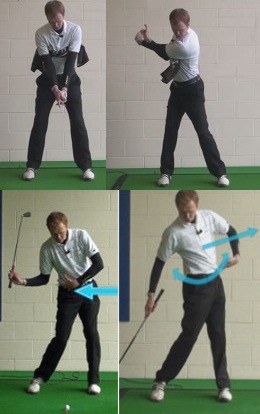
- Connected takeaway. As we mentioned above, one of the possible causes of an inside-out swing path is a poor takeaway that moves too far to the outside. To work on correcting that, try this simple drill. While you can perform this drill at the range, you aren’t even going to be hitting any shots with it – it’s a backswing-only drill. To get started, you’ll want to take one of your mid-irons from your bag, along with a couple of golf gloves. However, you aren’t going to be wearing those gloves – you’ll be placing on under each arm and trapping them in that position for the backswing. If you don’t have two gloves available, any other small, soft item will do the trick. With your gloves in place under your arms, take your stance and perform a backswing motion. The goal here is to keep the gloves securely in place throughout your backswing. To do so, you’ll have to keep your arms connected to your body nicely all the way to the top. If you let your arms move away too much during the takeaway, one or both of the gloves is going to fall. After a few successful repetitions of this drill, set those gloves to the side and go back to hitting normal shots. Try to keep in mind the sensation of staying connected with your arms and you should find that your takeaway path is improved as a result.
- Belt buckle to the target. This second drill is as simple as they get. In fact, you won’t even be doing anything different than normal when hitting your shots. You are just going to hit the ball down the range as you would usually, only you are going to check on one specific point after each swing. Once the ball is sent on its way, hold your finish position and look down to check on the position of your belt buckle (or the button on your pants or shorts, if you aren’t wearing a belt). The goal here is to have your belt buckle pointing out toward the target – or even a little left of the target – when the swing is finished. Getting into this position will confirm that you have done a good job of rotating your lower body in the downswing. If you fail to rotate this far, you might be sliding instead of turning, and we already talked earlier about how that can be a problem when it comes to pushed shot. If this drill reveals an issue, keep working on your lower body rotation in the downswing until you are able to get that belt buckle all the way around to the target time after time.
These two drills don’t really require any extra equipment, aside from a couple of spare golf gloves, and they are easy to do during any range session. By incorporating one or both of these drills into your next visit to the driving range, you can hopefully make progress away from your pattern of pushed shots.
— Push Shots in the Short Game
You can, of course, push your short game shots just like you can push any other kind of shot. Whether it is a putt from three feet away or a chip from off the side of the green, pushing the ball to the right of your intended line is a costly mistake. Let’s wrap up our article by quickly discussing how push shots can make their way into your short game.
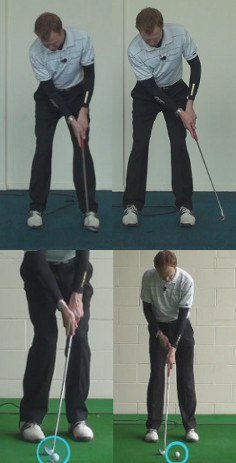
- Quitting on a putt. One common way to push a putt is simply to give up on the stroke. This often happens when the golfer lacks the confidence necessary to accelerate the putter all the way through the hitting area and toward the target. If you have doubts in the back of your mind as to whether or not you are going to make the putt you are facing, you might give up on the stroke at the last moment – and push the ball out to the right. This is a particularly common problem on short putts, where you know you should make it but still have some doubt about your ability to do so. If you have been pushing your short putts, the best thing you can do is spend some time during practice making as many of them as possible. By knocking in putt after putt from short range, you can build your confidence and hopefully leave those misses to the right in the past.
- Ball too far back when chipping. You have probably been told that you need to play the ball back in your stance when chipping, so you can strike the shot with a downward blow. And, to some degree, this is good advice. However, if you go too far and play the ball way back in your stance, you may end up consistently pushing these shots to the right of your intended line. When the ball is back near your right foot, it’s hard to square up the club properly by the time you reach impact. Consider moving your ball position just slightly forward for your standard chip shots – although still behind center – and you might find it easier to hit the target line. It will take some trial and error to dial in the perfect ball position for your chip shots, so be sure to include some chipping time as part of your standard practice session.
You don’t have to sit back and accept the push shots that are currently costing you strokes on the course. Sure, you won’t ever be able to eliminate them completely, but you can cut way back on push shots just by improving the basics of your swing technique. We hope the information in this article will help you make progress toward the goal of fewer push shots in the near future. Good luck!






